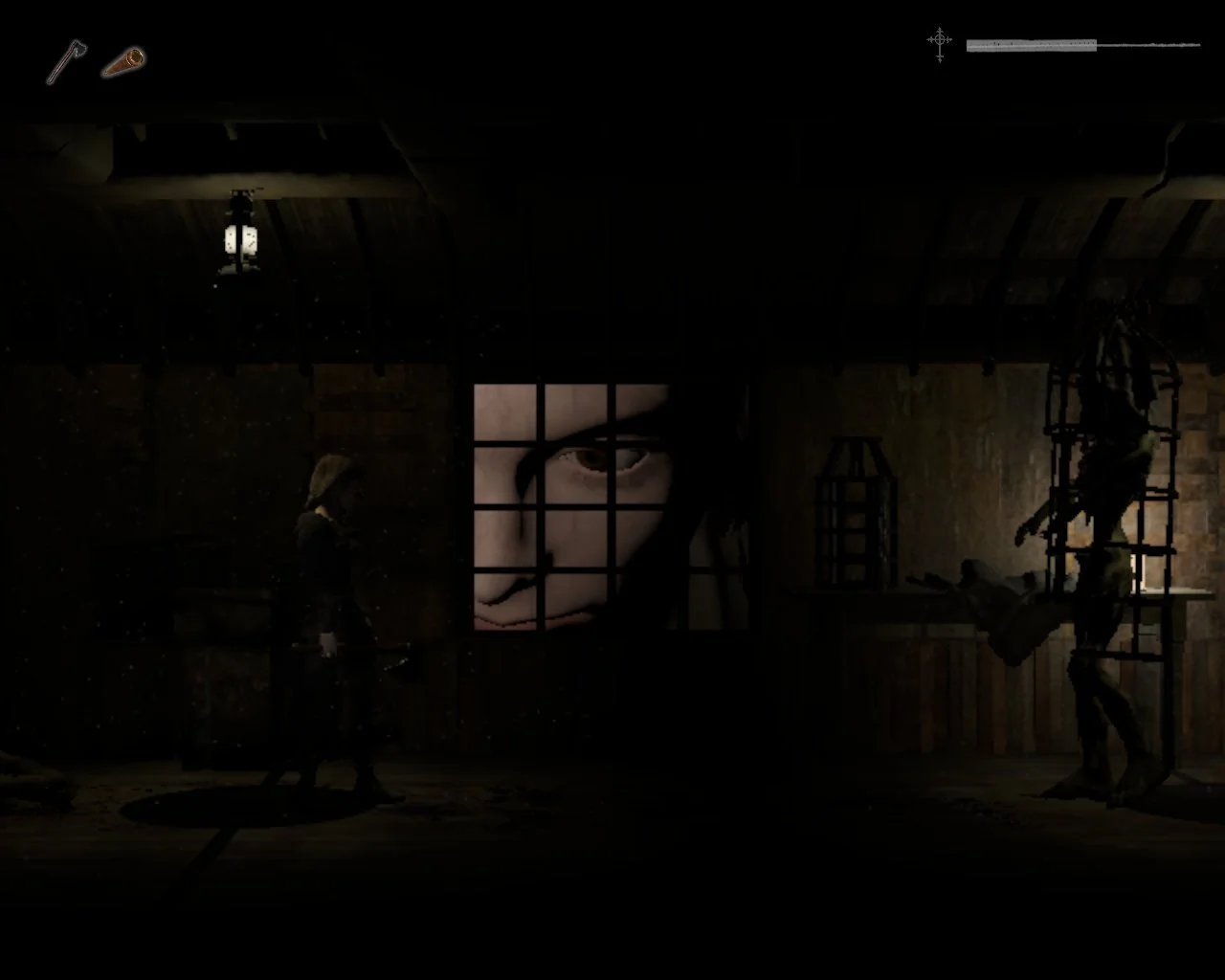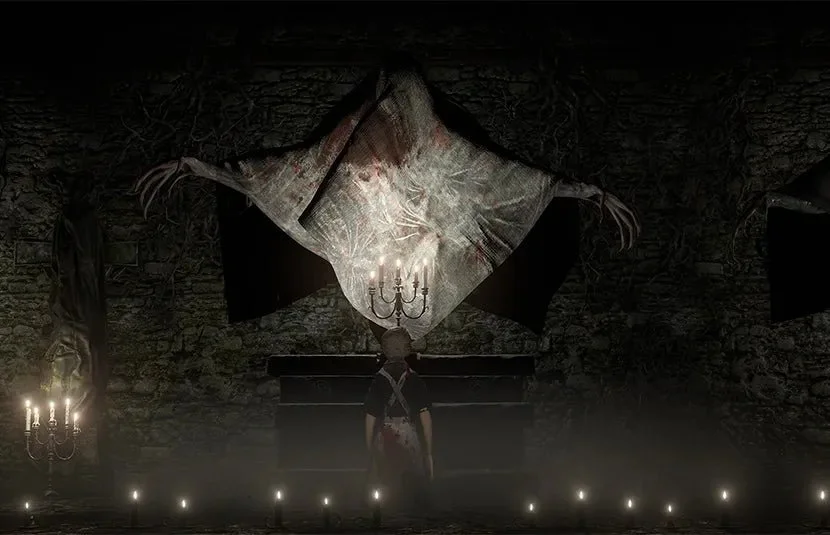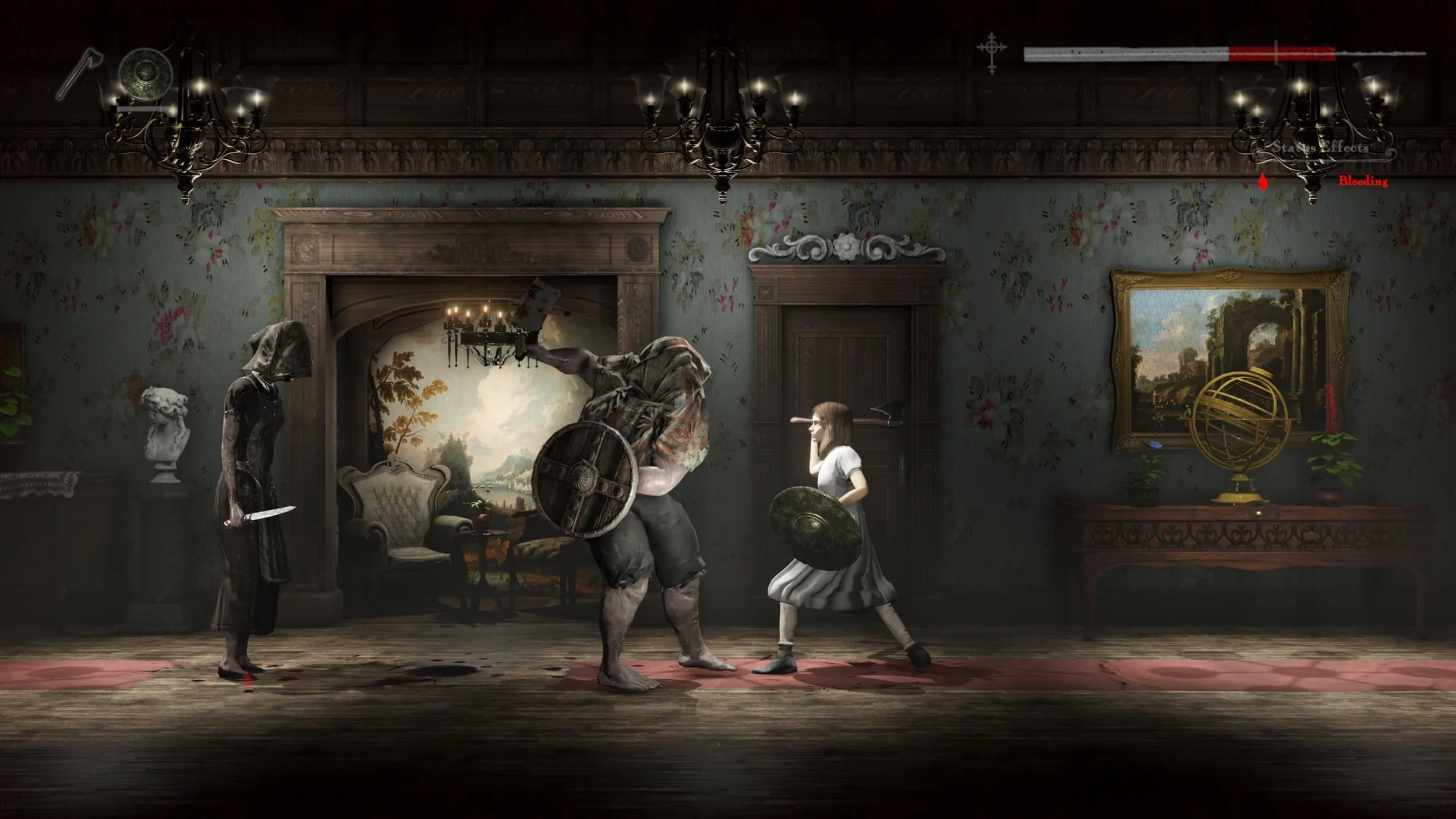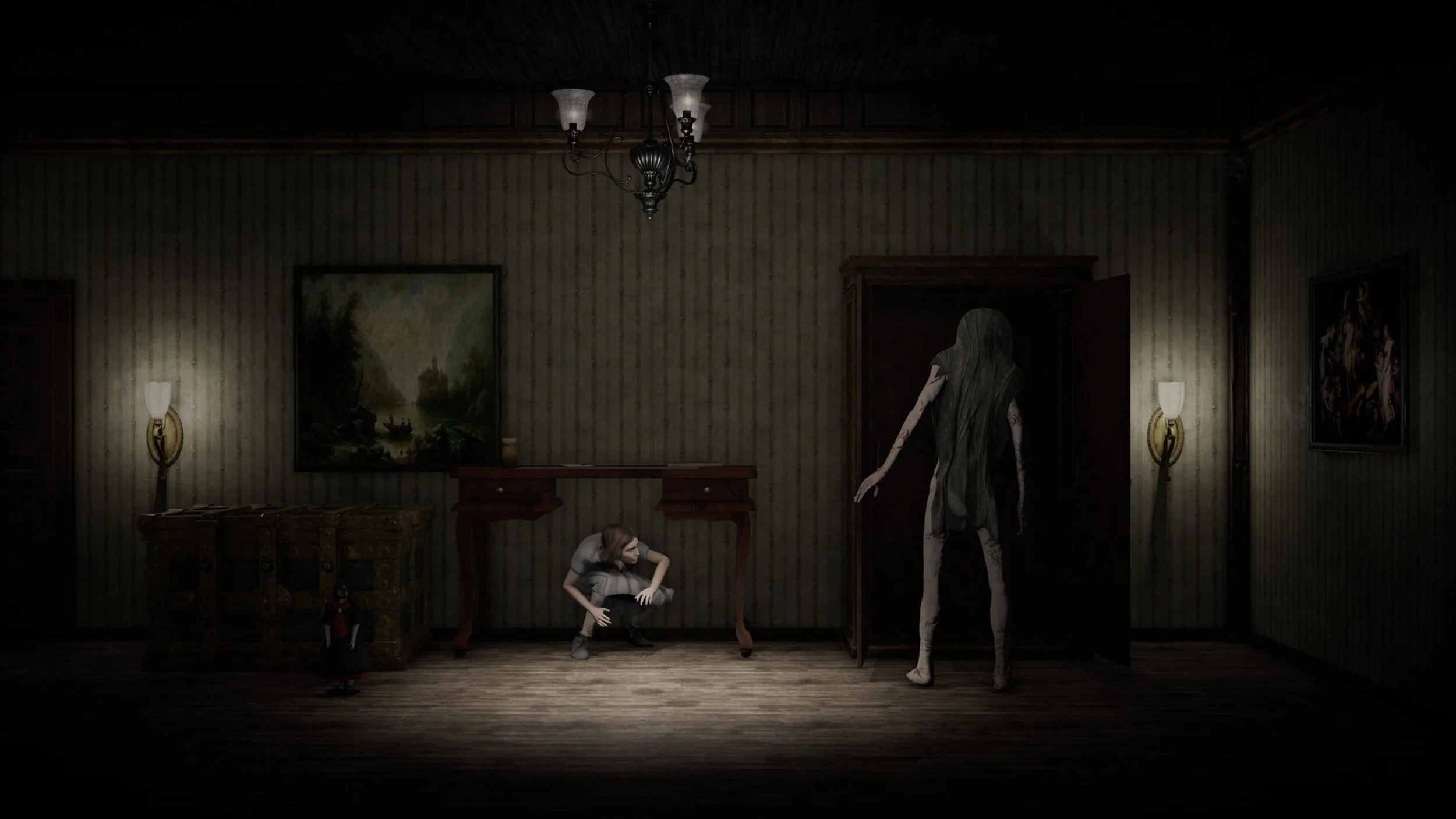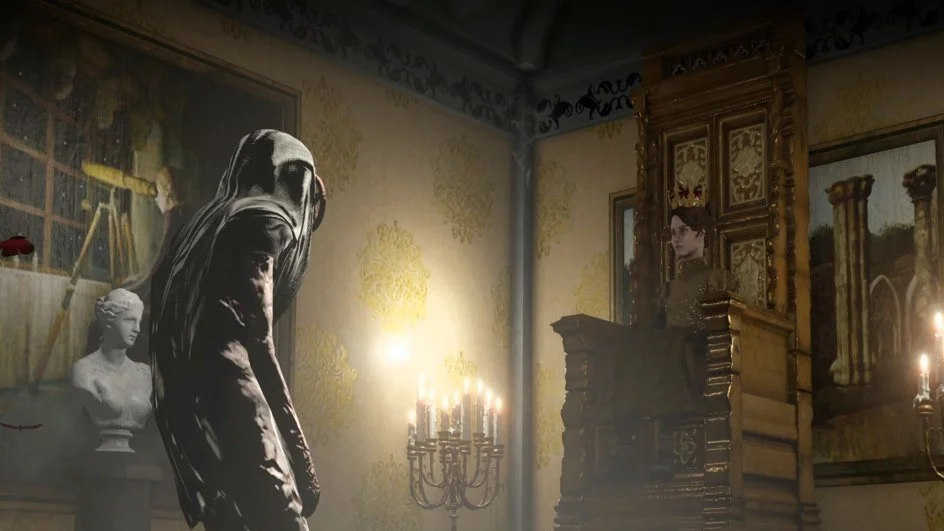
Withering Rooms ReviewBy Jared Elliott
Published May 10, 2025
The horror genre has been misunderstood and abused by mainstream studios for the better part of two decades, relying on intrepid and visionary indie developers for some much-needed life support. For a long time now, nearly every horror game of merit has been the product of the blood, sweat, and tears of small, resource-hungry studios - Visage, Iron Lung, and Darkwood come to mind.
Released by solo indie developer Moonless Formless in late 2022, Withering Rooms is the latest addition to this esteemed category of damn good horror games. It offers an engrossing and surprisingly deep experience, often reading like a passionate love letter to legendary horror titles of yore, but always retaining an undeniably unique and thoughtful presentation. The result is a fresh, new world full of resplendent mystery, disturbing discoveries, and many more hours of exploration than its $25 price tag would suggest.
We would be remiss to ignore the elephant in the room, which is that this review comes nearly three years too late. Our recent playthroughs of Withering Rooms were simply too good to ignore, however - and with Moonless Formless deep into development on his second game Withering Realms, we feel compelled to give this often-overlooked title the deep examination which it rightfully deserves.
As a final thought before jumping into the review, we want to commend Moonless Formless for producing such an expansive title with a credit roll that is shorter than our grocery list. Though sometimes flawed, Withering Rooms is a herculean effort which demonstrates boundless passion, creativity, and grit. Such an achievement is rare, and we respect the work that went into making this game so memorable.
Storytelling 8/10In the late 19th century, fifteen-year-old Nightingale is sent by her father to Mostyn House, a Victorian mansion turned asylum for troubled girls which is nestled deep in the woodlands of Monmouthshire, Wales. One night, she awakens to find herself trapped in a nearby gatehouse outside of the mansion, surrounded by grotesque, violent figures whom she must evade and outsmart in order to survive.
She manages to escape into the entrance hall of Mostyn House only to be confronted by a strange group of girls under the tutelage of the First Witch, a mysterious woman dressed in hooded robes who abruptly begins to interrogate her. Soon after, Nightingale learns suddenly and rather unpleasantly that she is a prisoner within an unending dream - one where magic exists, where reality is ever-twisting and formless, and where death itself does not offer escape.
Thus the player is confronted with several mysteries from the outset: What is the Dream? How did it come to exist? Is there a way out? Who is the First Witch? And what the hell is going on with Mostyn House? Over the course of the game, the answers to these questions (and many more) are revealed through environmental clues, extensive dialogue, letters, notes, and Dark Souls-esque item descriptions.
Exploration and player choice are significant factors in determining the outcome of the story as well as the fates of certain characters. Withering Rooms often confronts the player with consequential decisions which we may come to enjoy or regret along the way. This is not always true, however, as there are some tense moments where the player is confronted with the illusion of choice rather anticlimactically. These stick out like a sore thumb in comparison to the more impactful decisions available - though, in fairness, it took multiple playthroughs for us to notice.
Much like Dark Souls, Withering Rooms rewards the player’s curiosity and attention to detail with information key to unraveling the mysteries at hand. This can be a double-edged sword. On the one hand, players who appreciate world-building, dialogue, and investigation will find themselves enthralled - on the other hand, players who don’t enjoy these things will likely miss the depth of storytelling that the game offers.
As the game progresses, the story becomes somewhat convoluted and difficult to explain even for the curious. This can be credited to the ambitious depth of the story in part, but there were some elements which simply felt superfluous. It’s difficult to be specific while avoiding spoilers, so we’ll just say: “Inter-dimensional travel? In my Victorian fantasy-horror game?”
Otherwise, the storytelling of Withering Rooms is sophisticated and satisfying, with several memorable characters, a well-written script, and some genuinely thought-provoking dialogue. One moment in particular sticks out in our minds, in which a certain character relays a childhood story in order to describe the personality of her father - weaving in a bit of interesting history, developing two characters at the same time, and addressing the broader concepts of success and virtue in meaningful ways. This moment as well as others evoked a response of “Wow, this is good stuff” from us.
There are four endings in total. Two are immediately accessible at the end of the game in the form of a choice, one requires extensive exploration and exposure to some of the scariest content in the game, and another is only available in subsequent playthroughs.
Speaking of NG+, a variety of new content becomes available after completing the game, including new locations, new enemies, additional lore, new crafting options, additional leveling, and even an optional “hard” mode. This was all a very pleasant surprise, particularly because of the added context NG+ provides for one of the game’s most enigmatic and interesting figures.
Considering that this is an indie title by a solo developer, Withering Rooms is a standout when it comes to storytelling. Frankly, it does a better job than most AAA games at delivering a compelling and satisfying narrative, which is most impressive indeed.
Setting 9/10Put plainly, Withering Rooms looks and sounds gorgeous across its varied and expansive settings. Mostyn House stands out as a major set piece, full of exquisite paintings, statues, and furniture which morph into unsettling and sometimes horrific backdrops, both as the player becomes cursed and as the game progresses.
Mostyn House itself is only one of many explorable locations, each of which are unique and full of memorable surprises for those curious enough (or brave enough) to delve into them. Between cursed woods, forgotten Byzantine tombs, ancient Welsh ruins, a hellish cholera clinic, and many more locations - each with their own smatterings of brilliant music and sound design - there is an incredible breadth of discovery possible.
The atmosphere of certain locations captures a sense of dread which rivals some of Team Silent’s best work. The combination of lighting, location, sound design, and anticipation create numerous unforgettable moments - such as entering the boiler room in the basement of Mostyn House for the first time, discovering a haunted room only accessible by playing a “Bloody Mary” inspired game, or stumbling into a cult goddess’ lair.
Withering Rooms is also full of fun and even majestic locations, like a lively tavern hidden in the basement of a villager’s hut, a literal circus, and the inside of a mausoleum, which is enchanting in its overall presentation despite being a small and short-lived area. While these may seem like distractions on paper, the tonal shifts felt welcome and provided us with some time to breathe before diving back into the fray.
Enemies play an important role in the atmosphere of any given location. A cursed attic will be filled with ghosts and other various creeps; a wooded valley will contain demonic horses and angry villagers; and so on. With 89 unique entries in the game’s bestiary, the monster and boss designs are impressively varied, ranging from witches, to large beasts, to armored knights, to haunted paintings, and many more.
There’s little overlap in enemy design from location to location, though it does happen occasionally, and it can feel a bit jarring when it occurs. “What are you doing here?” came out of our mouths once or twice. In the grand scheme of things, these moments are few and far between, but noticeable.
Interestingly, when an enemy is defeated and looted for the first time, the game is paused and information about the creature is presented, including its name, stats, and a brief description of its backstory. We thought this was a nice touch, because the added context for each monster helps contribute to the overall setting.
Like monsters, NPCs are an important component of the overall setting and tone. These characters are usually found in safe rooms and offer players some background about the Dream, themselves, and the overarching plot. Some NPCs are quite memorable, others not so much - but nearly all of them serve a purpose, such as providing quests, skill leveling, or increasingly-strange services to the player.
Optional dialogue trees can feel sparse, with even major NPCs having little left to say for the rest of the game after their initial conversations have been exhausted or quests have been completed. In our opinion, a few more optional dialogues after significant events in the story would have helped to make the world feel more dynamic.
Ultimately, Withering Rooms crafts a world that’s as haunting as it is inventive, setting a high bar for indie horror. Great care was taken by Moonless Formless to craft a world which feels authentic, expansive, and full of surprises. For an indie game in particular, this is an impressive accomplishment, and it’s easily the best asset that this game has to offer.
Gameplay 7/10Every game has an Achilles heel, and Withering Rooms is no exception. Where is excels in its story and overall presentation, it falters somewhat in its core gameplay - namely in combat and its Rogue-like execution.
Starting with the good stuff - there’s a ton of variety in weapons, shields, spells, armor, rings, offensive and defensive items, status effects, et al. There are numerous selections in each of these categories, each with their own unique buffs, item descriptions, and upgrade potential. Multiple play styles are possible, and a comprehensive character leveling system allows players to customize and respect their build.
Taking a page from Dark Souls, status effects such as bleed, poison, curse, and paralysis are present, which can be inflicted on enemies or the player. Poise and stagger mechanics incentivize balance between speed of movement and the heaviness of defensive armor. Multiple damage types are present as well, including flame, lightning, and the aforementioned status effects.
The number of items is staggering, each with specific use cases - crafting, tactical diversions, healing, currency, and leveling are examples. Each item has a unique description which offers a healthy dose of lore and context to the game world.
As we mentioned in the previous section, the bestiary contains 89 unique enemies, again with tailored stats, movesets, strengths, weaknesses, and lore to go along with them. Several appear only in NG+, with one particularly nasty enemy only appearing in the game’s version of “hard mode.” On that note, we should mention that replay value for this game is off the charts.
Needless to say, there is an impressive amount of gameplay content and possibilities in Withering Rooms. It’s remarkable, especially for a solo-developed title, that these features feel so meaningful and cohesive. Moonless Formless really outdid himself here, and it shows.
However, for all its ambition, the gameplay isn’t without its flaws. Combat, in particular, often feels clunky - particularly with melee weapons, which offer little more than simple two- or three-hit light combos and single heavy attacks. Despite variances in range, damage, speed, and status effects, melee weapons feel somewhat interchangeable from a gameplay standpoint, because button-mashing is the primary and most useful method of delivering melee offense throughout the game.
Dodges and backsteps are available but rarely useful, because invincibility frames seem to lie somewhere between limited and non-existent. This means what seems like a well-timed dodge almost always turns out to be a free hit for the enemy. Add to that the ability of many enemies to strike behind their backs, or the ability of some to execute unblockable charge attacks, and you have a recipe for frustration. Shields are available to help mitigate this somewhat, but they degrade quickly, which means continual trips to merchants in order to stock up on more.
Guns are available from the mid-game onward. They are quite powerful, though they come with their own drawbacks. They are extremely loud, which attracts monsters to the player’s location, and they are slow to use and reload. In our playthroughs, we used them when melee combat was not the most viable option for an encounter, which was not often. In any case, ranged weapons add some variety, and with buffs and damage upgrades available for each, they can constitute a strong build.
Magic spells are available from the early game, which come in the form of spell scrolls which must be found or crafted, and then consumed in order to cast. Each time a spell is cast, there is a “spell toll” incurred which raises the player’s curse meter. When the curse meter is full, a status called “curse rot” is inflicted which rapidly drains health and must be reversed to avoid death. Because curse rot is so deadly, heavy use of magic requires the player to invest their leveling heavily into curse resistance and to obtain specialized gear before it becomes viable as a primary means of offense. Once it does, however, magic can be an extremely powerful weapon - almost too powerful.
With combat out of the way, we come now to a central mechanic of Withering Rooms - death means losing most of your items, such as health items, melee weapons, consumable spells, and ammunition. Exceptions include certain key items, unique items such as guns or armor, and items which the player has expended resources to “remember” for the next lifecycle. As the game progresses, more items can be remembered, and secret methods of obtaining lost items become available. This mitigates the blow of death somewhat, but even in the late game, it can leads to a tedious gameplay loop which we will explain later.
Death also has the unfortunate effect of wiping the player map (aside from known fast-travel locations) and rearranging all of the rooms. This means that when a player dies, important items and NPCs will be - well, somewhere else. Even the layout of rooms and position of NPCs will switch up, which is an unnecessary and sometimes obnoxious hindrance. Thankfully, the rooms are rearranged within a limited range - a single hallway or a single section of a forest, for example - and major landmarks remain in the same general locations, so “starting over” isn’t the blow that it might seem on paper.
The joint consequences of death - item loss and rearranging rooms - create a gameplay loop which can become tedious. The post-death recovery process typically involves visiting many of the same rooms, searching every conceivable shelf or piece of furniture for loot, and fighting the same enemies again and again. As the player levels up and obtains better gear, this merry-go-round becomes less common - but new players might find themselves stuck.
To help ameliorate the risks of exploration, Withering Rooms offers a couple of additional mechanics: peeking through doors and hiding. Hiding can be used to evade detection - though somewhat unreliably - and to dodge charge attacks which can’t be dodged otherwise. We practically forgot that this mechanic existed after a couple of hours due to its short-lived usefulness. Luckily there are other means to evade detection, such as disguising Nightingale as a zombie or using a specific item to become invisible for a brief period.
Peeking through doors is a useful way for players to scan a room for enemies before entering. It becomes less useful in the mid-to-late game, however, because virtually every room has enemies in them - so it’s easier to simply assume the presence of enemies through any closed door and to prepare accordingly. Even if the player is caught off-guard, gear can be swapped out in the pause menu with little consequence.
Overall, the gameplay of Withering Rooms excels in some areas and slogs in others. The jank is real, but not game-breaking or insurmountable, as our multiple playthroughs and 100% achievement completion can attest. We are impressed with the sheer variety of gameplay options and play styles which are possible, and the mechanics we found lacking have not detracted significantly from our overall enjoyment of the game.
Recent footage of the upcoming sequel indicates that Moonless Formless has learned some lessons from his debut project, so we look forward to seeing what improvements are in store for the future.
Animation 6/10Withering Rooms is something of an oddity in terms of animation. On one hand, many things looks great - lighting, backdrops, character models, and most monsters, from witches to haunted paintings, boast striking designs. The transformation of an area after becoming cursed is well-executed, and most combat situations are smooth enough to handle without much frustration. We appreciate the little moments too, like well-timed camera zooms to punctuate dialogue or spotting a ghost’s reflection in a nearby mirror.
For the most part, the game looks and feels great to play, even if animations can feel a bit awkward from time to time. Some movements can look strange and robotic - a stiff kick here, a clumsy roll there - but we found that this quirkiness contributes to the game’s charm rather than dragging it down.
However, technical issues on PC temper these strengths. We’ve run into two notable ones on PC. For reference, our rig is running Windows 11 with an Nvidia RTX 4080, an Intel i9 CPU, and 64GB of DDR4 memory. Our monitor refresh rate was set to 60Hz.
The first problem is significant frame rate drops. These happen consistently in just two or threes areas of the game, but unfortunately one of those areas happens to be the arena of a difficult boss battle. Otherwise it is a minor issue and doesn’t show itself often enough to warrant too many complaints.
The second problem is more serious - a bizarre shader issue that occurs every two hours or so. Perspective and camera changes that occur when walking through a door or using the telescope item, for example, will sometimes trigger the screen to flicker rapidly. The flickering remains until the next camera or perspective change, at which point the game window will black out entirely. On Windows, this can only be fixed by opening Task Manager with Ctrl + Shift + Esc on the keyboard, which “wakes up” the screen again and keeps the problem at bay for a couple of hours before it happens again.
Obviously, the second problem is annoying and most would likely consider it to be serious. We’re not sure if the problem exists on console, or if it’s specific to the PC version, but players on Steam might want to keep their keyboard handy.
Overall 8/10Despite its flaws, Withering Rooms earns its 8/10 as a rare gem where the whole surpasses the sum of its parts. It’s not perfect, but it accomplishes something that very few games manage to do, whether they come from global conglomerates or someone’s home office - it is utterly unique, charming, evocative, and memorable.
The story, music, and atmosphere alone elevate Withering Rooms. Then one considers the multitude of player choices, unique items, combat mechanics, quests, and endings on top of that - all compiled by a singular dev who dedicated hundreds, if not thousands of hours into this passion project - and the only describable emotion is a sense of awe. Without a doubt, this game is a product of love and toil, and we believe that it deserves recognition for what it really is - a damn good horror fantasy game with great music, tons of replay value, and plenty of unforgettable moments.
With all of that in mind, the problems that exist in the game takes a backseat to its assets. It’s a rare case where dealing with jank is worth the experience, kind of like fiddling with an old TV’s antennae to finish the rest of Casablanca—frustrating but worth it for the payoff.
Our hats are off to Moonless Formless for sticking the landing and providing audiences with a fantastic, unique horror experience. We look forward to his next title Withering Realms with a great deal of anticipation.
Meet the AuthorJared Elliott is a lifelong gamer, network engineer, and founder of Fan Fugue. He lives in the Great Plains region with his wife, Shayn, and his dog, Elvis.
